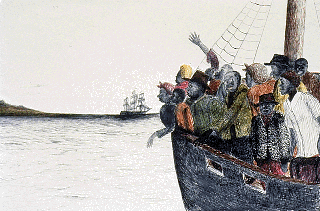
Nova Scotia's first settlers were the Mi' Kmaq people. Successive groups of immigrants have continued to come to Nova Scotia, pioneering a way of life to support their families and to contribute to the development of the province. This slide set and booklet resource will acquaint students with Black Nova Scotian pioneers who came to the province as Black Pioneer Loyalists in 1783 and as Black Pioneer Refugees of the War of 1812. This second group began to arrive in 1813. People of African descent were among the first pioneers of Nova Scotia. Many Black men and women have contributed to the settlement of Nova Scotia and Canada over the past 300 years, and continue to play major roles in Canada's development as a nation.
The slides, text segments and activities present the reasons why people of African descent came to Nova Scotia, the hardships they faced, the communities they developed through work and persistence, their lifestyles and occupations, the development of a religious foundation which continues to sustain Black communities and individuals, and the early education and schooling experienced by pioneers of African descent.
Directions: To introduce students to this package of resources, project the slides and read the accompanying notes aloud. You may wish to reproduce the Brief Slide Notes for student reference. A more detailed examination of each slide and background information is provided in successive sections of this document to support a detailed exploration of aspects of Black Pioneer life in Nova Scotia.
Slide 1
Black pioneers came to Nova Scotia in two major migrations, 1783 and 1813, from the Thirteen British Colonies which became the United States of America. Most Black Pioneers came to Nova Scotia by ship. 1500 Black Pioneers landed at Port Roseway, now Shelburne. Thick forest grew down to the coastline. Black Pioneers of 1812 landed at the busy port of Halifax and at Annapolis Royal.
Slides 2-4
These slides illustrate what life was like for Black Pioneers upon their arrival in Nova Scotia. We learn about land clearing, provisioning, where and how supplies were obtained, and the hardships faced and overcome by Black Pioneers.
Slide 2 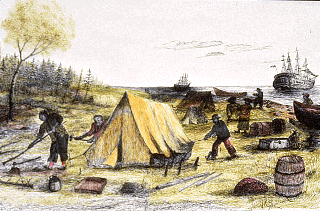
Many Black Pioneers of 1783 slept in tents and crude huts until homes could be built. Those who were members of the military often stayed aboard ship, as did wealthier white Loyalists. In 1813, Black Loyalists stayed in tents, at alm houses in Halifax and in other available buildings until land was provided for settlement.
Slide 3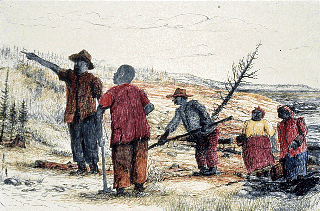
Clearing the land and planting a garden were important first activities of Black Pioneers. Those from the New England area had experienced a similar climate and soil; those from the Southern States struggled to adapt successfully. The Black Pioneers of 1783 established Birchtown, Brindleytown, Tracadie and the Preston area. The Preston area was also the home of the Jamaican Maroons from 1796 to 1800. In 1800, the Jamaican Maroons left for Sierra Leone.
Slide 4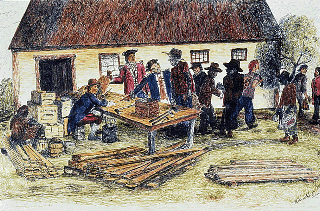
Provisions for settlement came from the military commissary. Black Loyalist Pioneers did not receive all the seeds, lumber, tools, assistance and land which they were promised and which were necessary to avoid undue hardship. Many had to work at low pay to obtain the provisions which had been promised for free. Most received land with poor soil or no land at all.
Slides 5-7 5 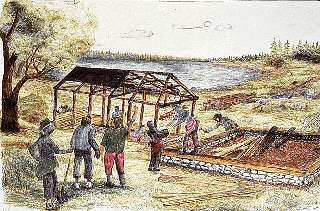 6
6 
7 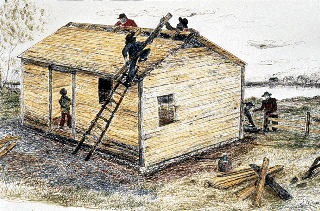
When the pioneers of African descent arrived in Nova Scotia in 1783 and 1812 as free persons, indentured servants and as slaves, they needed to build homes. They were employed to build some of the first towns in Nova Scotia. Many were excellent carpenters.
Slide 8 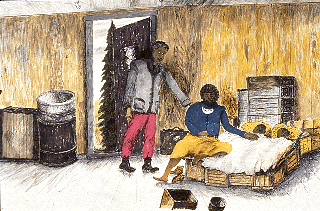
These pioneers had few possessions and little money to bring to Nova Scotia. Many slept on beds made of boxes and used warm furs as blankets during the winter. Families had few children as they learned to make full use of the resources of the environment.
Slide 9 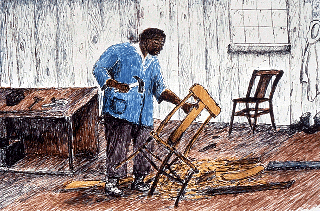
The majority were highly skilled tradespeople who had learned carpentry, farming, marketing, and furniture making through a system of apprenticeship on large farms and plantations in the United States.
Slide 10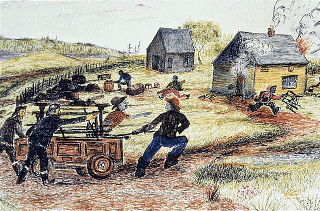
Skilled chimney sweeps kept the community safe from fire. The chimney sweeps kept the wooden chimneys of the 2000 wooden houses of Shelburne in good working order, free of soot and creasote. Fire could easily destroy an entire community as fire fighting was very difficult. Any family which did not properly maintain a chimney had to pay a fine for endangering the rest of the community.
Slide 11
Chimney sweeps were vital to the security of the community against the threat of fire. Fire was a feared enemy of the settlers.
Slide 12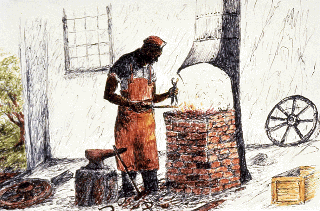
Blacksmiths made the community's nails, shod the oxen and horses, and made any metal objects needed by the community's homes and businesses.
Slide 13
Other trades and services needed by the community included: rope maker, shoe maker, sawyer, miller, tanner, painter, coachman, clothier, farmer, domestic mason, millwright, weaver, skinner, tavern servant, coachman, minister, medical doctor, midwife and teacher.
Slide 14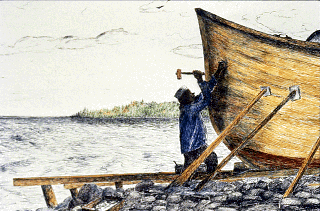
Black Pioneers built sailing ships for the cod and whale fishing industries. Black pilots and navigators kept the sailing vessels safe from reefs and other dangers. As fishermen and seamen, they contributed to the growth of the fishing industry and the prosperity of Nova Scotia. In Preston, Shelburne, Brindleytown and Weymouth, many pioneers fished for personal and community use to add to the food they produced on their farms.
Slide 15
Although they were skilled workers, they were unable to compete successfully for jobs against white former soldiers who were also looking for employment. In July 1784, disbanded white soldiers chased Black Pioneer workers from the town of Shelburne and burned their homes. This was Canada's first race riot. Desperate for work and an income when the promises of free land were not fulfilled, many free people of African descent became indentured servants to survive. This was a form of slavery.
Slide 16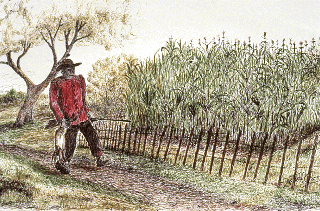
The forests had many moose, deer, beaver and bear, porcupine and rabbit. Hunting was a main source of food until gardens could be planted and farm animals purchased. The animals of the forest provided fresh meat when the barrels of salted pork the settlers had brought with them from the United States were consumed. The settlers reused their barrels to preserve wild meats from the forest, birds and fowl.
Slide 17
Subsistence farming, share cropping and indentured farm work were the three ways in which Black Pioneers participated in farming. They grew beans, turnips, peas, carrots, parsnips, onions, cabbage, potatoes and grains. They gathered wild vegetables from the forests and cooked them over an outdoor fire in a large stew kettle. As farms were established, farmers from the Preston area brought farm products to the Halifax Green and other markets to sell.
Slide 18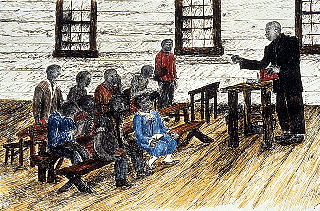
Often, the most important aspects of a child's education happened within the family. Many of the first schools in the Black communities were established by the Anglican Church and later by the Black Baptist Churches. The people of the community contributed their labour and materials to build a school which often also served as the community's church.
Slide
19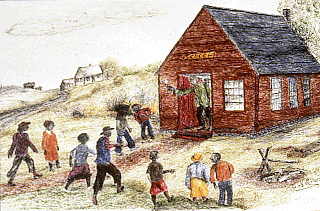
The school teacher was often also the minister of the church. At this time, most schools taught a very basic education based upon memory drills and practical work skills such as sewing and manual labour. Writing and arithmetic were not stressed. Generally, education for Black Pioneers prepared them only to be servants in the homes of others.
Slide 20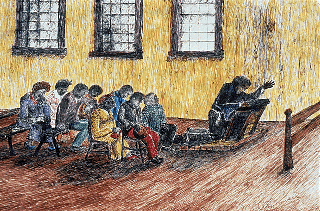
The Black Pioneers' greatest success was religious organization. The Church was the one institution which they controlled and organized independently. Churches provided leadership, community development and change within the Black Pioneer communities of 1783 and 1813. Churches were vital organizations which provided training to preachers, teachers, politicians and professionals of the community. They were key supports in the community's ability and will to survive difficult circumstances.
Slide 21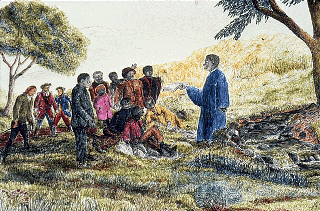
The Pioneers participated in the Anglican, Methodist, Huntingtonian, Black Baptist, Zion African Methodist Episcopal, and Roman Catholic Churches.
Slide 22
The first religious services of these Pioneers were often held outdoors in a clearing or field, or in the home of a community member, with an itinerant (travelling) minister in attendance. With time, church buildings were erected. The buildings often served as both church and community school.
Slide 23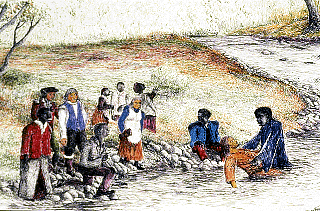
Baptism was an very important religious ceremony of the Black Pioneers. Baptism was often performed in a lake, stream, or river by the minister. All members of the congregation were on hand to welcome the new member of the Church.
Slide 24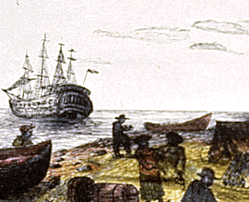
By 1791 it was obvious that Nova Scotia government officials were not going to supply land grants with suitable soil for farming to the Black Pioneers. 1196 people decided to leave Nova Scotia and its broken promises to settle in Sierra Leone. On January 15, 1792, fifteen ships left Halifax for Sierra Leone. They carried some of the Black Pioneers' most vital community members -- its teachers, ministers and skilled crafts people -- to a land of better promise.
Back to Nova Scotia Black Pioneers Index